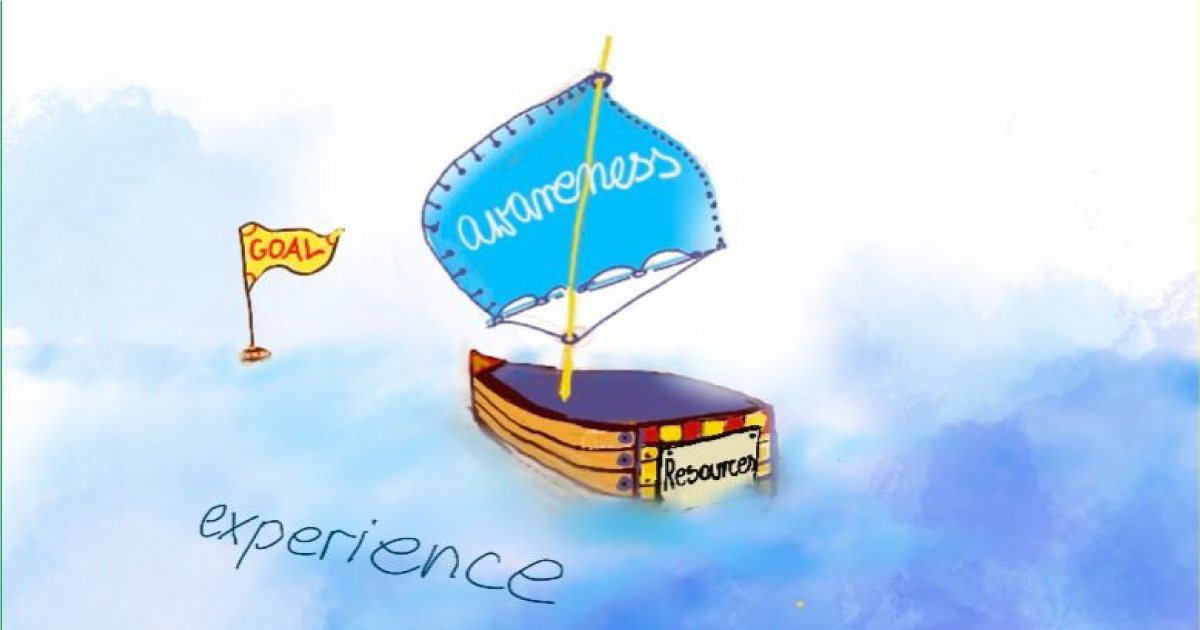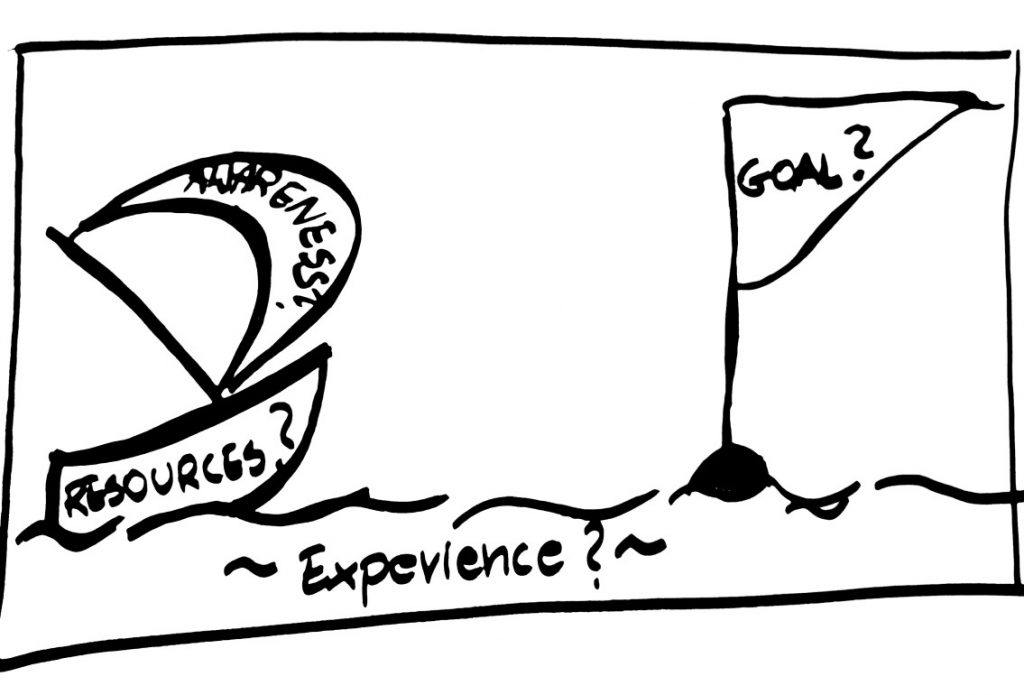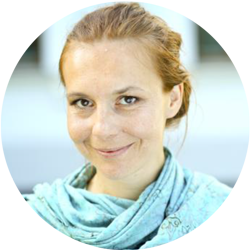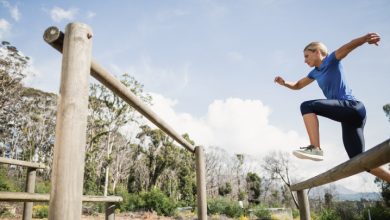Personalized Competence Model
In this article you will be invited to think critically about competence models, you will learn 3 main set of competences in the non-formal education. And finally, you will design your own competence model for a personalized learning journey.

Why did I choose this tool?
The term “competence” got into our everyday language of educators, trainers and youth workers. It is important to understand what “competence” means.
How does this apply to a trainer?
Our understanding of competence defines us as learners. The competence is strictly connected to learning-to-learn category.

Content:
Competency Based Education (CBE) is a visible trend in a nowadays formal education. The philosophy of competences has also been introduced to a non-formal education field, where both attendees as well as facilitators have a possibility to learn and to develop professionally, by recognizing their own achievements within particular competences.
Competencies are closely related to learner’s attributes and refer to specific patterns of behavior that enable someone to perform a task at the required standard.
Competencies can be defined as: ‘combinations of knowledge, skills and attitudes, which facilitate the application of knowledge to real world contexts’ (see Cook & Weaving, 2013). The OECD (2005) says that competency ‘involves the ability to meet complex demands by drawing on and mobilizing psychosocial resources (including skills and attitudes) in particular contexts’.
What is interesting, competences took a role of management and monitoring of different curriculums in different areas of education. We are dealing nowadays with a phenomenon called ‘Technocratization of competence’, which is highlighted in the book by Knut Illaries:
„However, great problems have also developed concerning the definition and application of the competence concept. This is primarily because a number of national and supranational bodies have taken over the concept and sought to implement it as a management tool. Wide-ranging work has been initiated to define a number of competences that the various education programs should aim at and to make these measurable in order to make it possible to judge whether the efforts succeed (see Illeris. 2004).”
This problem was developing so dynamically across Europe, that it became a priori neglected and widely incorporated into educational systems.
Illeris concludes that „competence development may be promoted in environments where learning takes place in connection with a (retrospective) actualization of relevant experience and contexts, that (at the same time) interplay between relevant activities and interpretation of these activities in a theoretical conceptual framework, and a (prospective) reflection and perspective.”
Therefore, working in a field of non-formal education we should be aware of 3 different sets of competences described in:
- YOUTHPASS
- YOUTH WORK COMPETENCE
- ETS COMPETENCE MODEL
YOUTHPASS
Youthpass is a tool to document and recognize learning outcomes from youth work and solidarity activities. It is available for projects funded by Erasmus+: Youth in Action program, and will be made available for the European Solidarity Corps.
There is a set of 8 key competences for youth and youth workers, described in details in documents concerning YOUTHPASS (https://www.youthpass.eu).
The 8 Key competences:
- Communication in the mother tongue;
- Communication in foreign languages;
- Mathematical competence and basic competences in science and technology;
- Digital competence;
- Learning to learn;
- Social and civic competences;
- Sense of initiative and entrepreneurship;
- Cultural awareness and expression.
YOUTH WORK COMPETENCE
The Portfolio for YOUTH WORKER, created by the Council of Europe, looks at those things which the youth worker usually or most commonly does. They call these functions of youth work.
The competences that one needs to have in order to do youth work have been divided into two categories:
Specific youth work competences – competences that make this field of activity unique.
More general competences – competences relevant for other fields of activity but which are usually important for youth work.
List of functions and competences for youth work:
Function 1. Address the needs and aspirations of young people
COMPETENCE 1.1 Build positive, non-judgmental relationships with young people
COMPETENCE 1.2 Understand the social context of young people’s lives
COMPETENCE 1.3 Involve young people in the planning, delivery and evaluation of youth work by using participatory methods as suitable
COMPETENCE 1.4 Relate to young people as equals
COMPETENCE 1.5 Demonstrate openness in discussing young people’s personal and emotional issues, when raised in the youth work context
Function 2. Provide learning opportunities for young people
COMPETENCE 2.1 Support young people in identifying their learning needs, wishes and styles, taking any special needs into consideration
COMPETENCE 2.2 Create safe, motivating and inclusive learning environments for individuals and groups
COMPETENCE 2.3 Use a range of educational methods including ones that develop creativity and foster motivation for learning
COMPETENCE 2.4 Provide young people with appropriate guidance and feedback
COMPETENCE 2.5 Inform young people about learning opportunities and support them to use them effectively
Function 3. Support and empower young people in making sense of the society they live in and in engaging with it
COMPETENCE 3.1 Assist young people to identify and take responsibility for the role they want to have in their community and society
COMPETENCE 3.2 Support young people to identify goals, develop strategies and organize individual and collective action for social change
COMPETENCE 3.3 Support young people to develop their critical thinking and understanding about society and power, how social and political systems work, and how they can have an influence on them
COMPETENCE 3.4 Support the competence and confidence development of young people
Function 4. Support young people in actively and constructively addressing intercultural relations
COMPETENCE 4.1 Support young people in acquiring intercultural competences
COMPETENCE 4.2 Promote interaction between young people who come from diverse backgrounds at home and abroad so that they can learn about other countries, cultural contexts, political beliefs, religions, etc.
COMPETENCE 4.3 Work creatively on and with conflicts with a view to transforming them constructively
COMPETENCE 4.4 Actively include young people from a diverse range of backgrounds and identifications in youth work activities
Function 5. Actively practice evaluation to improve the quality of the youth work conducted
COMPETENCE 5.1 Involve young people in planning and organizing evaluation
COMPETENCE 5.2 Plan and apply a range of participatory methods of evaluation
COMPETENCE 5.3 Use the results of evaluation for the improvement of their practice
COMPETENCE 5.4 Stay up-to-date on the latest youth research on the situation and needs of the young people
Function 6. Support collective learning in teams
COMPETENCE 6.1 Actively evaluate teamwork with colleagues and use the results to improve effectiveness
COMPETENCE 6.2 Seek and give feedback about teamwork
COMPETENCE 6.3 Share relevant information and practices in youth work with colleagues
Function 7. Contribute to the development of their organization and to make policies / programs that work better for young people
COMPETENCE 7.1 Actively involve young people in shaping their organization’s policies and programs
COMPETENCE 7.2 Co-operate with others to shape youth policies
Function 8. Develop, conduct and evaluate projects
COMPETENCE 8.1 Apply project management approaches
COMPETENCE 8.2 Seek and manage resources
COMPETENCE 8.3 Give visibility to projects, write reports and make presentations, for a variety of audiences
COMPETENCE 8.4 Use information and communication technology tools when necessary
The European Training Strategy Competence Model (ETSCM ) defines 7 competence areas, targeting trainers, youth workers and youth leaders working on an international level:
- Understanding and facilitating individual and group learning processes
- Learning to learn
- Designing educational programs
- Cooperating successfully in teams
- Communicating meaningfully with others
- Intercultural competence
- Being civically engaged
The self-assessment toll is provided on SALTO website: https://www.salto-youth.net/rc/training-and-cooperation/trainercompetencedevelopment/trainercompetences/)
Nevertheless, technocratisation of competence remains as a topic to be discussed in the near future because we don’t know which standards and criteria are objectively defining a particular competence.
How should we measure a skill?
How to measure an awareness?
How to measure knowledge?
Is it possible to have one competence developed 100%?
Nevertheless, this discourse should not take away the essence of self-assessment and autonomous learning, as such.
We should keep critical thinking and still learn from available materials and concepts.
We can definitely refer to a self-assessment tools, and in a future use: “AppRaiser. 360° professional development appraisal service for trainers” to train our learning muscle.
We should design our professional development journey as autonomous learners.
Exercise:
LEARNING JOURNEY:
This exercise will help you to analyze your preferences and will inspire your individual learning plan.
Pick a random competence from those earlier mentioned and answer the following questions:
(you may use Trainers Competence Cards for Self-Assessment, free download https://www.salto-youth.net/rc/training-and-cooperation/trainercompetencedevelopment/trainercompetences/)

- COMPETENCE: Write the name of a chosen competence, how do you understand it?
- IMPORTANCE: How important this competence is in your professional life as a trainer? Give it a rating 5 – very important, or 1 – not important.
- INTENTION: To what extent would you like to develop this particular competence? What would you like to achieve in terms of knowledge, skills, attitude and performance? Describe how this competence would manifest in your professional life? How would you recognize a difference?
- LEARNING JOURNEY: What do you need to develop this competence? What kind of resources do you need (people, books, films)? What kind of experience would you like to arrange (supervision session, taking part in a training, developing your own method etc.)? How would you like to increase your awareness, and improve your attitude referring to this competence?
- FIRST STEP: What could be your first step towards your intended vision?
| COMPETENCE: | IMPORTANCE 1 – 5 | INTENTION: | LEARNING JOURNEY: | FIRST STEP |
| Resources?: Experience?: Awareness? |
||||
| Resources?: Experience?: Awareness?: |
||||
| Resources?: Experience?: Awareness? |
||||
| Resources?: Experience?: Awareness? |
||||
| Resources?: Experience?: Awareness? |
When you are ready with the list, choose the competences of highest importance and create your own, individualized learning plan for next months.
“My learning intention is to develop the competence/s ……………………………….. because……………………………………………………………………………………………
My first step would be ………………………………………………………………………….”
Reflection questions:
- To what extent is the awareness of your own competence profile supporting your development as a trainer?
- Is there any other competence that you think is not included in the models given in the article?
- How often and at what intervals do you think you should verify your own competency model?
- Should competency models change or remain the same?
- If you were to present your competency model representing you, what would it look like?





